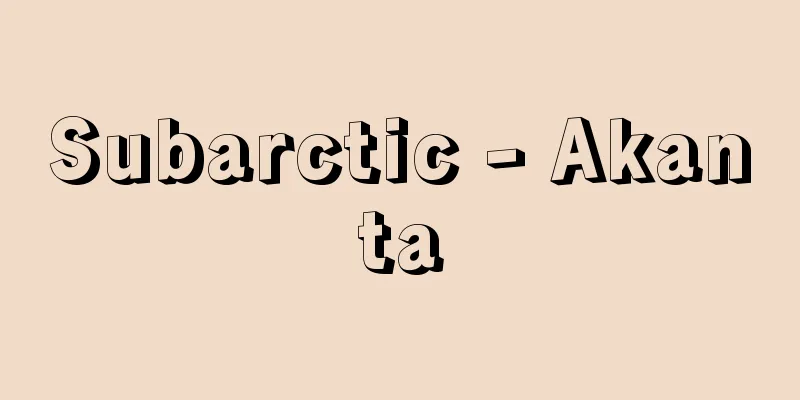Private broadcasting - Minkan Hoso

|
A broadcasting company whose main source of operating funds comes from revenues other than the national budget or reception fees (usually advertising revenues or paid revenues). In Japan, this refers to broadcasting companies other than the Japan Broadcasting Corporation (NHK) and the Open University of Japan. The Broadcasting Act uses the term "general broadcasting company" (Chapter 3). Usually, it is called a commercial broadcasting company. [Yasuhiro Iyoda] Differences with NHKPrivate broadcasters are like NHK in that they broadcast programs with a broadcasting station license under the Radio Law, but there are significant differences in the nature of their business entities. The first difference is in their legal entity status. NHK is a special legal entity established under the Broadcast Law and is not profit-making, whereas private broadcasters are free to be non-profit foundations or profit-making corporations. Currently, all private broadcasters are corporations. In the past, the Japan Cultural Broadcasting Association (now Nippon Cultural Broadcasting), Tokyo Channel 12 (now TV Tokyo), and Far East Broadcasting (now FM Okinawa) were once foundations. The second difference is in their financial sources. NHK is funded by receiving fees collected directly from viewers under Article 32 of the Broadcast Law, whereas private broadcasters are primarily funded by advertising broadcast fees paid by advertisers for terrestrial broadcasting and monthly subscription revenues for satellite broadcasting. The third difference is the broadcasting area: NHK's "purpose is to broadcast so that its programs can be received throughout Japan" (Article 7 of the Broadcasting Act), whereas commercial terrestrial broadcasters are generally regional broadcasters (prefectural broadcasters) limited to certain areas that roughly correspond to the regional divisions of local governments. Commercial terrestrial broadcasters broadcast nationwide through a network. [Yasuhiro Iyoda] radioIn 1950 (Showa 25), new broadcasting legislation was enacted in line with the new constitution, including the Radio Law and the Broadcast Law, which reorganized the Japan Broadcasting Corporation, the only broadcasting entity up until that point, into a special corporation, and private broadcasting was permitted. On September 1, 1951, Chubu Nippon Broadcasting and New Japan Broadcasting (now Mainichi Broadcasting System) opened as the first private broadcasting stations, and began medium wave broadcasting. By 1954, the number of private medium wave radio stations had reached 39, covering almost the entire country. Also, in August 1954, Japan Shortwave Broadcasting (now Nikkei Radio Corporation), the only private shortwave broadcasting station, opened. The focus of new commercial radio stations then shifted to FM broadcasting, with FM Aichi being the first to open in 1969, followed by three more in 1970, and then, after a 10-year hiatus, five more, including FM Ehime, opened in 1982. Since then, commercial FM stations have opened in various regions based on the Ministry of Posts and Telecommunications' (now the Ministry of Internal Affairs and Communications) policy of one station per prefecture, and Japan, like the United States, has entered an era of full-scale AM and FM competition. As of July 1997, there were 47 AM (including 36 TV-operated) companies, one shortwave company, and 49 FM companies (including three foreign language broadcasting companies), for a total of 97 companies. On January 10, 1992, the Ministry of Posts and Telecommunications ordinance allowed the establishment of "community broadcasting" as a new audio medium, and the first station, FM Iruka (Hakodate, Hokkaido), opened on December 24 of the same year. Community broadcasting is a small-scale broadcasting with a maximum output of 20 watts, and can be considered the broadcast version of a "town magazine." As of April 2000, 131 stations have been established. [Yasuhiro Iyoda] TelevisionNippon Television Network Corporation obtained a preliminary license for commercial television stations on July 31, 1952, ahead of NHK, and began broadcasting on August 28, 1953. This was followed by Radio Tokyo Television (now Tokyo Broadcasting System, or TBS) in 1955, and from 1956 to 1958, one company each in Osaka, Nagoya, Sapporo, and Fukuoka, with stations being established in major cities first. In 1957, the Ministry of Posts and Telecommunications expanded television frequencies from six channels to twelve, and issued preliminary licenses to establish 34 new commercial television stations nationwide, with the establishment of television stations progressing from 1958 to 1960. Television receivers became popular rapidly following the marriage of the Crown Prince (now the Emperor) in April 1959 (the number of receiving contracts as of that month was about 2 million), and by March 1962 the number had topped 10 million. The last television station using the very high frequency band (VHF) was broadcast in 1964 with the launch of Tokyo Channel 12. Since then, with Gifu Broadcasting taking the lead in 1968, television stations using the ultra high frequency band (UHF) have been broadcast all over the country. As of the end of July 1997, there were 126 commercial television stations (excluding satellite operators), of which 48 were VHF stations (34 of which were also radio stations) and 78 were UHF stations (2 of which were also radio stations). In April 1991, the first commercial satellite (BS) broadcasting service, Japan Satellite Broadcasting (abbreviated as WOWOW), began. In May 1992, CS television broadcasting using communication satellites began, and in October 1996, Perfect TV launched Japan's first CS digital broadcasting service. [Yasuhiro Iyoda] RegulationLike NHK, private broadcasters are regulated by the Radio Law as a type of radio station, and their operation is regulated by the Broadcast Law. In addition, as part of the administrative policy of the Ministry of Posts and Telecommunications (now the Ministry of Internal Affairs and Communications) regarding the application of the provision of Article 9 of the Ministry of Posts and Telecommunications Ordinance "Fundamental Standards for the Establishment of Broadcasting Stations" (Radio Regulatory Commission Regulation No. 21 of 1950), which states that "it must contribute to the fair and efficient dissemination of broadcasting," private broadcasters are subject to regulations such as that license applicants must be as closely connected to the local community as possible in terms of personnel and capital, that one entity must not control two or more companies, and that one entity must not control the three major mass media of television, radio, and newspapers in the same local community (principle of elimination of mass media concentration). In addition to administrative regulations based on these laws and directives, there is also self-regulation, with the broadcasting standards established by the Japan Commercial Broadcasters Association (JBA), an industry group, serving as the standard for the evaluation of programs and commercials by commercial broadcasters. In addition, each broadcaster has an inspection section that checks programs and commercials on a daily basis, and has set up a program council made up of external academic experts to check management and programming activities in general. In addition, television text broadcasting operators (nine companies as of the end of July 1997) whose establishment was permitted under the revised Broadcasting Law that came into effect on December 1, 1982, are also included in general broadcasting operators, that is, private broadcasting operators. [Yasuhiro Iyoda] "Japan Commercial Broadcasting Association, ed., Japan Commercial Broadcasting Yearbook, various editions (Koken Publishing)" ▽ "Japan Commercial Broadcasting Association, ed., 'A Thirty-Year History of Commercial Broadcasting' (1981)" [Reference items] | | | | | | |Japan Commercial Broadcasters Association| | | | | SystemSource: Shogakukan Encyclopedia Nipponica About Encyclopedia Nipponica Information | Legend |
|
主たる運営財源を国家予算や受信料収入以外の収入(通常は広告収入または有料収入)によっている放送事業者。日本の場合、日本放送協会(NHK)、放送大学学園以外の放送事業者をさす。放送法では「一般放送事業者」の名称が使われている(3章)。通常、民放という。 [伊豫田康弘] NHKとの相違民放は、電波法による放送局の免許を受けて番組を放送するという点ではNHKと同じだが、事業体の性格には大きな違いがある。第一は法人格の相違であり、NHKが放送法に基づいて設立された特殊法人で、営利を目的としていないのに対し、民放の法人格については法律による規定がなく、したがって非営利の財団法人であろうと、営利の株式会社組織であろうと、自由である。現在はすべての民放が株式会社である。かつては日本文化放送協会(現文化放送)、東京12チャンネル(現テレビ東京)、極東放送(現エフエム沖縄)が一時期財団法人であった。第二の相違は財源で、NHKの運営が放送法第32条に基づき視聴者から直接徴収する受信料でまかなわれているのに対し、民放は、地上波では広告主企業の支払う広告放送料金、衛星波では月極めの有料収入を主要な財源としていることである。第三の相違は放送区域で、NHKが「あまねく日本全国において受信できるように放送を行うことを目的とする」(放送法7条)のに対し、地上波の民放はおおむね地方行政の地域区分に一致した一定の地域に限定された地域放送(県域放送)が原則である。地上波の民放の全国放送は、ネットワークを通じて行われる。 [伊豫田康弘] ラジオ1950年(昭和25)に新憲法に即した新しい放送法制として、電波法、放送法などが成立し、それまで唯一の放送事業体だった社団法人日本放送協会を特殊法人に改組するとともに、民間の放送が認められ、翌51年9月1日、中部日本放送と新日本放送(現毎日放送)の両局が民放第1号として開局、中波放送を開始した。民放の中波ラジオ局は54年に39社に達し、ほぼ全国的な置局を遂げた。また、54年8月には民放唯一の短波放送局である日本短波放送(現日経ラジオ社)が開局した。民放ラジオの新規開局は、その後、FM放送に焦点が移り、69年のエフエム愛知を皮切りに、70年に3社が開局、その後10年余りの空白期間を経て82年にエフエム愛媛など5社が開局、以後、郵政省(現総務省)の1県1局の置局方針に基づき各地に民放FM局が開局、日本もアメリカ同様、本格的な中波・FM競合時代を迎えている。97年(平成9)7月現在、民放ラジオ(地上波)の社数は中波47社(うちテレビ兼営36社)、短波1社、FM49社(うち外国語放送3社)の合計97社となっている。なお、FM放送では1992年1月10日に新たな音声媒体として「コミュニティ放送」の開設が認められ(郵政省令)、その第1号局「FMいるか」(北海道函館(はこだて)市)が同年12月24日開局した。コミュニティ放送は最大出力20ワットの小規模放送で、「タウン誌」の放送版ともいうべきものである。2000年4月現在で131局が開局している。 [伊豫田康弘] テレビジョン民放テレビ局は、日本テレビ放送網が1952年7月31日にNHKに先だって予備免許を得、53年8月28日開局した。続いて、55年にラジオ東京テレビ(現東京放送=TBS)、56年から58年にかけて大阪、名古屋、札幌、福岡各市に各1社ずつ、まず大都市から置局されていった。57年に郵政省はテレビ周波数を6チャンネル制から12チャンネル制に拡大、全国に民放テレビ34社を新設する一斉予備免許を行い、58年から60年にかけてテレビの全国置局が進行した。テレビ受信機は59年4月の皇太子(現天皇)ご成婚を契機に急速に普及(同月時点での受信契約数約200万台)、62年3月で1000万台を突破した。超短波帯(VHF)を使うテレビ局は、64年の東京12チャンネルの開局で終止符を打ち、以降は68年の岐阜放送をトップに、極超短波帯(UHF)使用のテレビ局が全国各地に開局している。民放テレビ局(地上波)は97年7月末現在、126社(衛星系業者を除く)、このうちVHF局は48社(うちラジオ兼営34社)、UHF局は78社(ラジオ兼営2社)である。91年4月からは、初の衛星(BS)民放、日本衛星放送(略称WOWOW(ワウワウ))のサービスが開始された。92年5月には通信衛星を利用するCSテレビ放送が始まり、さらに96年10月、パーフェクTVによる日本初のCSデジタル放送がスタートした。 [伊豫田康弘] 規制民放もNHK同様、無線局の一種として電波法の規制を、また運用について放送法の規制を受けている。ほかに民放については、郵政省令「放送局の開設の根本的基準」(昭和25年電波監理委員会規則21号)第9条、「放送の公正かつ能率的な普及に役立つものでなければならない」旨の規定の適用に関する郵政省(現総務省)の行政方針として、免許申請者が人的・資本的にできるだけ地域社会に密着していること、同一主体が2社以上を支配してはならないこと、同一地域社会でテレビ、ラジオ、新聞の三大マス・メディアを同一主体が支配することのないようにすること(マス・メディア集中排除原則)、などの規制が行われている。こうした法令や通達に基づく行政規制の一方、自主規制として、業界団体である社団法人日本民間放送連盟(民放連)の定める放送基準が、民放各社の番組・CMの考査の規範となっており、また各社レベルでも考査セクションを置き、番組やCMのチェックを日常的に行うほか、外部の学識経験者による番組審議会を設置して、経営・番組活動全般のチェックを行っている。 なお、1982年12月1日施行の改正放送法で設立の認められたテレビ文字多重放送事業者(97年7月末現在9社)も一般放送事業者、つまり民間放送に含まれる。 [伊豫田康弘] 『日本民間放送連盟編『日本民間放送年鑑』各年版(コーケン出版)』▽『日本民間放送連盟編・刊『民間放送三十年史』(1981)』 [参照項目] | | | | | | | | | | | |出典 小学館 日本大百科全書(ニッポニカ)日本大百科全書(ニッポニカ)について 情報 | 凡例 |
<<: Folk medicine - Minkanyaku
>>: Civil defense - minkanbouei (English spelling)
Recommend
Prymnesiophyceae
…The migratory cells are characterized by having ...
Sakuragaoka ruins - Sakuragaoka ruins
Located in Sakuragaoka-cho, Nada-ku, Kobe City, th...
《Hanjō Shinbun》 - Kanjō Shinbun
...After that, the newspaper was often suspended ...
Jesuitendrama
…Wordplay and allegorical painting also emerged d...
Institutio Christianae religionis (Latin)
A work by the Genevan Reformer John Calvin. Writt...
Retina - Momaku (English spelling)
The retina is the innermost membrane of the eyeba...
LHA - LHA
A type of file compression and decompression softw...
Yoriki - Yoriki
Also written as Yoriki. Originating in the Kamaku...
Heinrich Lersch
German poet. He took over his father's busine...
Rice handling celebration - Inekokiwai
…The mindset for using these kinds of employees i...
Ophichthus urolophus (English spelling) Ophichthusurolophus
...The body is gray-brown, without markings, but ...
ZANU
...A referendum on a new constitution was held in...
brightyoung
…The Roaring Twenties, translated as the Roaring ...
Fingal's Cave - Fingal's Cave
A cave on the island of Staffa in the Inner Hebrid...
Grab - grab
…Bugaku Costumes and Crotches (2) The formal dres...






![Nakayama [town] - Nakayama](/upload/images/67cc64ed8d28e.webp)


